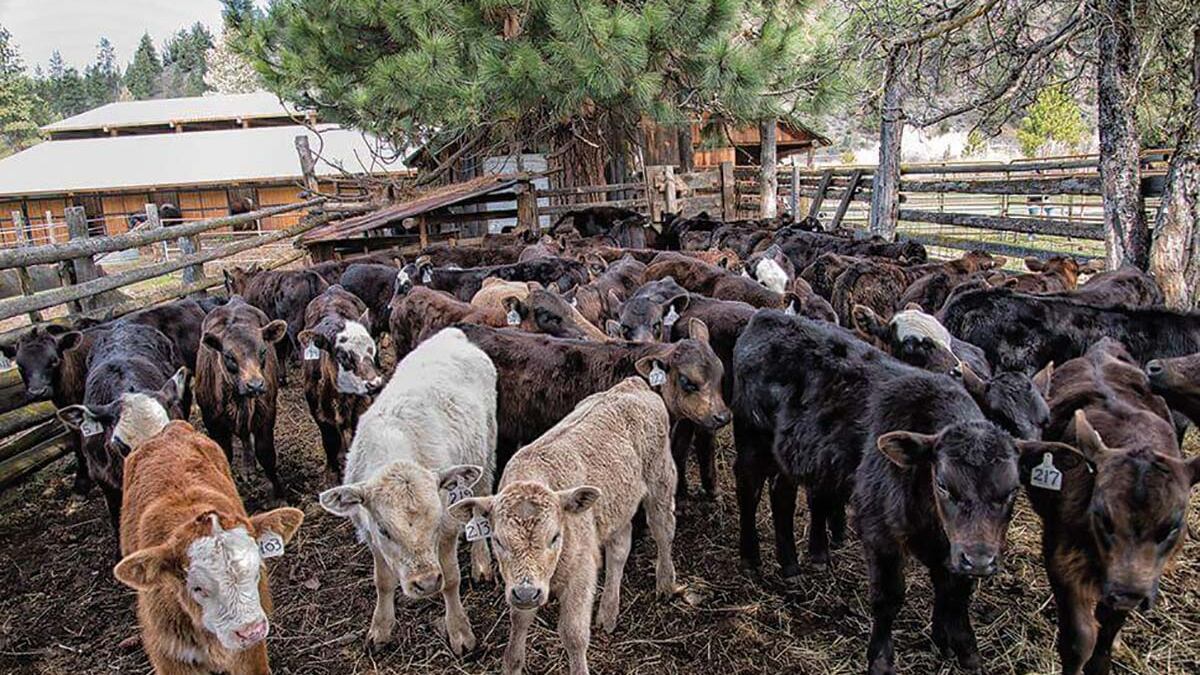Five men surround a wooden pen and brace themselves for a struggle. One climbs atop the highest railing and gets into position. On the opposite side, another holds a loosely looped rope. A third man firms up his stance behind a gate as the final two wait nearby, ready to jump in if needed.
Given all of that preparation, you might assume this robust lot of ranchers is about to wrestle a 1-ton bull. Instead, the goal is to give a reluctant cow her biannual shot.
"OK?" the one behind the metal barrier asks.
"Let's go!" replies the man wielding the lasso.
With too many moving parts, it's difficult to tell who prompts the big, black cow to step toward the chute, but that forward progress doesn't last long. The animal jerks sideways and attempts to turn, prompting the man behind the gate to push all his weight against it to keep her from getting loose. But the effort is no match for this bovine's powerful pectoral muscles and stubborn personality. She shoves back and ends up right where she started.
Mary Beyer, one of the owners of Wine Down Ranch (6500 McKay Creek Road, Prineville, 503-810-7003, winedownranch.com), watches the situation unfold a few feet away, turns to me and says, "We've got a trouble cow."
It wasn't the first time she'd put up a fight. Most cows are hesitant to enter the narrow enclosure, but in general are quickly guided into the apparatus that hugs their torso for the few seconds it takes to vaccinate and apply dewormer. But not this one. After about 15 minutes of back and forth, the men give up and let her free in the paddock.
Cow immunizations are just one of several chores on that day's list for Mary, her husband, Roy, and the handful of family and friends who gather to help. And as a guest at their bunkhouse sandwiched between the Beyers' home and the fenced-in meadow where horses and dogs have the freedom to roam—including one very audacious pup that makes a game of sneaking up behind the stallions to give their tails a tug before darting away—I'm welcome to stay and learn about ranch work through observation for as long as I please.
Anyone can, actually. If you've always dreamed of driving cattle over mountain ranges and through rivers—well, that won't happen here. But the 2,100-acre plot that includes rounded hills studded with stout juniper trees on one side and jagged ridges thick with towering lodgepole pines on the other is about as close as you can get to a dude ranch experience on Highway 26 in Oregon. From feeding the cows to fence mending, there's plenty to do—it all depends on how hands-on you want to get. It's also OK to retreat inside the cabin for a game of Scrabble if you simply want to hang out on the ranch but not necessarily help make it run.
The Beyers weren't always in the business of birthing, feeding and castrating a herd of animals. Before moving to the property in 2012, the couple lived in Molalla—Roy worked as a tree farmer and Mary co-owned a wine bar. It was his decade-plus-long desire to retire 20 minutes outside of Prineville and the request that his wife give ranching at least two years that prompted the fresh start. What began as two has now grown to seven, and if their life after work actually sounds harder than their former occupations in the valley, Mary's descriptions of past summers when every day was spent horseback riding through old-growth ponderosa forests moving livestock from pasture to pasture says it all.
"It can be long days," she explains, "but it's fun."
During those seven years, the family appears to have become some of the most popular folks in town. Everyone from the bartender at Crooked River Brewing to the owner of a local bike shop will chime in with a story about the Beyers and their cows if you happen to mention you're staying at Wine Down. The ranch is deeply rooted in the community as one of the key partners of the Crooked River Open Pastures, or CROP, Farmers Market and Farm Events educational initiative, which seeks to connect consumers to the source of their food. The Beyers' adult daughter Alia and her partner, Laura Johnson-Fujiyama, are heavily involved.
"Crook County is a food desert," says Johnson-Fujiyama, who is also the organization's president. "We have some of the highest grocery store prices in the state."
It's the extremes that make agriculture in this region such a challenge. The soil is practically hostile to most crops—sandy and volcanic with a basic pH, the dirt needs to be nourished and cultivated before any seeds are planted. And the weather fluctuates wildly. A scorching few weeks of summer can shift unexpectedly to an early September frost. The CROP program, then, not only invites the average person to learn more about the farms that ring their city; it's also sort of a public celebration showcasing all of the extra effort it takes to get anything to grow.
There's really nothing easy about working the land or with animals. After the cattle are vaccinated during my visit—the Beyers have about 30 Chianina-Black Angus (I'm told the crossbreed makes for a calmer cow since a pure Angus is known to be a bit of a hothead)—their calves are up next. But as a novice rancher, I must admit their procedure is tougher to witness. Since herds are turned out in the Ochocos during the summer for grazing, some 50,000 acres of land, owners need to be able to identify their cattle if lost or rustled. Branding is still the most effective way to keep track of that livestock.
Knowing what's about to happen, I become a little wobbly and lightheaded when it's time to turn our attention to the babies. The distressed chorus of moos from the mothers who've been separated from their offspring only tightens the knot in my stomach. After the first calf is lined up in the chute, some of the adult cows began aggressively advancing, so we slide to the other side of a gate in case any of them decide to get too close. The branding doesn't last long—a plume of smoke and an aroma of leather mixed with burnt hair dryer hangs in the air. But maybe I was more nervous than I needed to be. As soon as it's over, the little gal trots away like nothing happened.
Seeing every aspect of a ranch—not just the cute stuff—is a valuable lesson for anyone who eats meat, forcing you to confront complex and sometimes uncomfortable realities concealed by those plastic-wrapped, 3-pound cylinders of ground beef from the grocery store. It is a business, first and foremost. However, if anyone loves their cows, it's this family. They can tell you the name, history and personality of each and every one, like Popsicle, who was born in such frigid temperatures the Beyers brought her inside to warm up next to their wood stove, and Halo the sterile female, who was bottle-fed and will eat grain out of your hands.
After lunch, the cows are rounded up and guided across the road to the hills. When I drive by them that evening, I look over and smile, happy the stress of the day is over, they've all been reunited and are now munching the ground. I'm pretty sure I couldn't be a ranch hand. Yeah, I'd be downright lousy at the gig. But I am grateful there are people with more mettle who raise cattle humanely and sustainably, demonstrating they care deeply about their labor.

